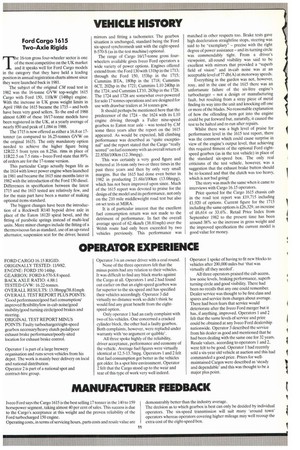VEHICLE HISTORY
Page 127

If you've noticed an error in this article please click here to report it so we can fix it.
Ford Cargo 1615 Two-Axle Rigids The 16-ton gross four-wheeler sector is one of the most competitive on the UK market and it speaks well for Ford Cargo models in the category that they have held a leading position in annual registration charts almost since they were launched back in 1981.
The subject of the original CM road test in 1982 was the 16-tonne GVW top-weight 1615 Cargo with Ford 150, 110kW (148hp) engine. With the increase in UK gross weight limits in April 1988 the 1615 became the 1715and both have been very good sellers. To the end of 1988 almost 6,000 of these 16/17-tonne models have been registered in the UK, at a yearly average of nearly 850 and peak of 1,084 in 1988.
The 1715 is now offered as either a 16.8 or 17tonner (as compared to 16.25-tonnes GVW on the original 1615). The only mandatory option needed to achieve the higher figure being 12R22.5 front tyres on 8.25in. rims in place of 11R22.5 on 7.5 rims Iveco Ford state that 89% of orders are for the 17-tonne version.
This particular Cargo actually began life as the 1614 with lower power engine when launched in 1981 and became the 1615 nine months later in 1982 with the introduction of the Ford 150 diesel. Differences in specification between the latest 1715 and the 1615 tested are relatively few, and for the main part have been a matter of making optional items standard.
The biggest changes have been the introduction of a Rockwell R140 hypoid drive axle in place of the Eaton 18120 spiral bevel, and the fitting of parabolic springs instead of multi-leaf units. More minor changes include the fitting of a thermoviscous fan as standard, use of an up-rated alternator, suspension seat for the driver, heated mirrors and fitting a tachometer. The gearbox situation is unchanged, standard being the Ford six-speed synchromesh unit with the eight-speed 8-570-S (as in the test machine) optional.
The range of Cargo 16/17-tonne gross fourwheelers available gives Iveco Ford operators a wide variety of power options. Engines offered extend from: the Ford 130 with 131hp in the 1713; through the Ford 150, 153hp in the 1715; Cummins BTA, 180hp in the 1718; Cummins 6CT, 202hp in the 1721; Cummins LIO 240hp in the 1724; and Cummins LT10, 283hp in the 1728. The 1724 and 1728 are somewhat over-powered for solo 17 tonnes operations and are designed for use with drawbar trailers at 34 tonnes gcw.
It should perhaps be mentioned here that the predecessor of the 1724 the 1624 with its L10 engine driving through a Fuller nine-speed gearbox to Eaton rear axle was tested by CM some three years after the report on the 1615 appeared. As would be expected, hill climbing performance was described as "quite exceptional" and the report stated that the Cargo "really scored" on fuel economy with an overall return of 22.851it/100km (12.36mpg).
This was certainly a very good figure and bettered at 16-tons only two or three times in the past three years and then by only very small margins. But the 1615 had done even better in 1982 in producting 21.61it/100km (13.08rnpg), which has not been improved upon since. Much of the 1615 report was devoted to praise for the design of the model and its performance, not only on the 210 mile middleweight road test but also on set tests at MIRA.
It is of particular interest that the excellent fuel consumption return was not made to the detriment of performance. In fact the overall average speed of 62.4km/h (38.81mph) over the Welsh route had only been exceeded by two vehicles previously. This performance was matched in other respects too. Brake tests gave high deceleration straightline stops, steering was said to be "exemplary" precise with the right degree of power assistance -and its turning circle was commendably tight. From a driver's viewpoint, all-round visibility was said to be excellent with mirrors that provided a "superb field of vision" and in-cab noise was at an acceptable level of 77 db(A) at motorway speeds.
Everything in the garden was not, however, rosy, and in the case of the 1615 there was an unfortunate failure of the six-litre engine's turbocharger not a design or manufacturing fault, but resulting from a stray piece of metal finding its way into the unit and knocking off one or more of the blades. No reasonable explanation of how the offending item got into the engine could be put forward but, naturally, it caused the test to be halted and re-run after repairs.
Whilst there was a high level of praise for performance level in the 1615 test report, there was the comment which could cause surprise in view of the engine's output level, that achieving this required fitment of the optional Ford eightspeed gearbox (as in the test vehicle) in place of the standard six-speed box. The only real criticisms of the test vehicle, however, was a suggestion that the exhaust brake button should be re-located and that the clutch was too heavy, which is not bad going!
The story was much the same when it came to interviews with Cargo 16.15 operators.
Price quoted for the Cargo 1615 chassis cab in the road test report was £19,715 including £1,920 of options. Current figure for the 1715 including the same options is126,329, an increase of £6,614 or 33.6%. Retail Price Index from September 1982 to the present time has been around 38% so the increase in gross weight and the improved specification the current model is good value for money.




























































































































































































